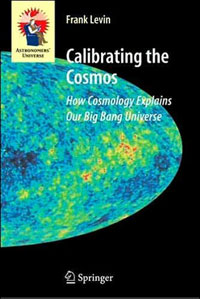|
|
Review: Calibrating the Cosmos
by Jeff Foust
Monday, August 27, 2007
Calibrating the Cosmos: How Cosmology Explains Our Big Bang Universe
by Frank Levin
Springer, 2007
hardcover, 302 pp., illus.
ISBN 0-387-30778-4
US$29.95
There is a hole in the universe. Not a black hole, mind you, but an empty space up to a billion light-years across, devoid of both visible and dark matter. That bit of vaguely disturbing news, announced by University of Minnesota astronomers last week, is hardly atypical for research on the cutting edge of astronomy. Such research involves either time and distance scales far beyond what ordinary people can easily comprehend (billions of light-years or billions of years, for example) or concepts that are utterly foreign (dark matter or dark energy). For those wishing to learn more about the universe and its origins, a good place to begin is Frank Levin’s Calibrating the Cosmos.
| Calibrating the Cosmos is aimed at a particular audience: people who don’t know much about cosmology, but who are relatively intelligent and motivated to learn. |
Levin starts with some basic principles regarding how distances are measured, be they on the Earth or in the universe, as well as some basics about electromagnetic radiation, then builds up the reader’s knowledge about the universe and its origins. He examines some key issues in astronomy and cosmology, including the lives and deaths of stars, the expansion of the universe, and the origins and early history of the universe. Unlike many other astronomy books, there’s very little in the way of colorful imagery of stars and galaxies in Calibrating the Cosmos; instead, Levin makes far more use of charts and graphs to illustrate his discussion of astronomical concepts like the Hubble Constant.
Calibrating the Cosmos is aimed at a particular audience: people who don’t know much about cosmology, but who are relatively intelligent and motivated to learn. (Levin based the book on a course on cosmology he developed for adult education programs.) As a result, the book starts on some very basic foundations, but builds up quickly, and Levin is not afraid to pepper the text with relatively advanced terminology, variables, and a few equations. This is not Cosmology for Dummies, but instead a useful book for those who don’t know a lot about cosmology but are interested in learning more and who don’t need their education sugarcoated with a lot of pretty pictures. It won’t help you understand why, for example, there’s a hole a billion light-years across in the universe—not even the astronomers who found it know why it exists—but it will help you understand the significance of such discoveries.
Jeff Foust (jeff@thespacereview.com) is the editor and publisher of The Space Review. He also operates the Spacetoday.net web site and the Space Politics and Personal Spaceflight weblogs. Views and opinions expressed in this article are those of the author alone, and do not represent the official positions of any organization or company, including the Futron Corporation, the author’s employer.
|
|
